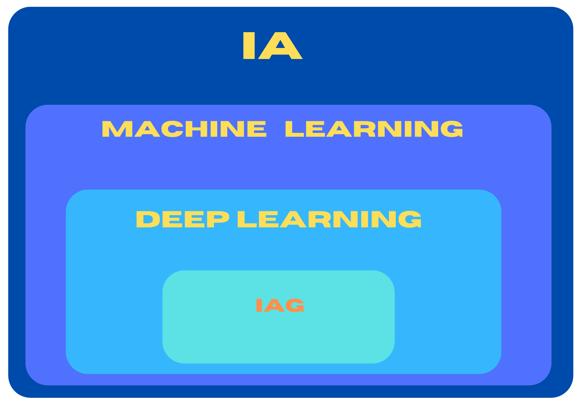1.3. How do we classify AI?
Artificial intelligence can be classified in several ways, such as by how it learns or functions, its features or its aims. We will focus on classification by type of learning.
- Machine learning. Computer systems are set up to use data to learn and improve, without requiring explicit programming. There are three main subcategories:
- Supervised learning. Labelled datasets are used to train algorithms that can then make accurate predictions about new data. It is used, for example, in applications such as email sorting (to differentiate spam from non-spam) and medical diagnoses (e.g. diagnosing melanomas).
- Unsupervised learning. The models learn from unlabelled data to discover hidden patterns or to cluster data. This includes tasks such as data clustering and dimensionality reduction, which are useful for data analysis and customer segmentation, for example.
- Reinforcement learning. The models learn through interacting with a dynamic environment and make decisions with feedback in the form of rewards or penalties. It is used, for example, in applications such as autonomous driving and training robots.
- Deep learning. A branch of artificial intelligence that uses neural network models to learn and understand complex patterns in data. Its features include:
- Deep neural networks. They consist of multiple layers of interconnected neurons inspired by how the human brain works. Each layer processes information and transmits the output to the next layers, allowing hierarchical learning.
- Representational capacity. With multiple layers, this type of AI can learn to represent highly complex data patterns, making it suitable for tasks such as image recognition, natural language processing, and other areas involving complex data.
- Hierarchical learning. Successive layers learn representations of data with multiple levels of abstraction. For example, in image recognition, the initial layers detect basic shapes, while deeper layers identify more complex patterns.
- Input processing with many dimensions. Dimensions are structures identifying the different attributes or variables that describe each instance of the data. The ability to manipulate large amounts of data with many dimensions is key to many applications, as it allows models to capture subtle and complex details in the data.
- Large quantities of data and computing power. Huge quantities of data are required to train these models in order to obtain the best results, calling for enormous computing power.
- The applications of deep learning AI.
- Image recognition. Identifying objects and patterns in images, e.g. distinguishing cats from dogs.
- Natural language processing (NLP), e.g., machine translation, sentiment analysis and text generation.
- Computer vision. Facial recognition, object segmentation, etc.
- Voice recognition. Converting voice to text and vice versa.
- Computer games. Learning optimal policies in games such as Go and video games.
- Programming language code. Generating or modifying program code.
Generative artificial intelligence falls within the deep learning category of AI. A graphic representation would look like this:

This form of artificial intelligence, GAI, learns automatically from data. It analyses immense amounts of data, finds patterns and relationships that would otherwise be difficult to detect and creates original material from that data.
Generative AI uses generative adversarial networks (GANs) that are based on two neural networks, a generator and a discriminator. The generator is responsible for creating new content, while the discriminator differentiates between genuine and simulated data. This interaction between generator and discriminator allows AI to learn from data effectively and efficiently, generating high-quality, realistic new content.